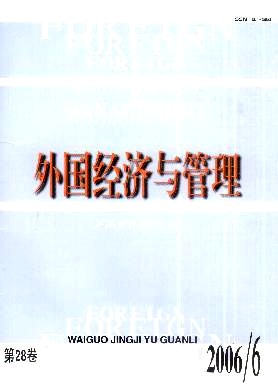国外科技型员工创业行为研究综述
外国经济与管理 2006 年 第 28 卷第 06 期, 页码:19 - 25
摘要
参考文献
摘要
当今高科技产业的一个新特征,就是市场竞争通常是由高科技企业科技型员工离职创业所导致的。本文围绕高科技企业科技型员工创业这个主题,从员工的创业选择、企业的策略性行为、对社会技术创新的影响以及相关法律等方面回顾了国外学者研究这一问题的基本思路和结论,并简要分析了这些研究对我国政府制定高科技产业政策的启示意义。
[1]Saxenian,A.Regional advantage:culture and competition in Silicon Valley and Route 128[M].Cambridge,Mass.:Har-vard University Press,1994.
[2]Arrow,K J.The rate and direction of inventive activity[M].New York:Princeton University Press,1962:609-625.
[3]Zucker,L,and Darby M.Intellectual capital and the birth of US biotechnology enterprises[J].American Economic Re-view,1998,88(1):290-306.
[4]Pakes,A,and S Nitzan.Optimum contracts for research personnel,research employment,and the establishment of rivalenterprises[J].Journal of Labor Economics,1983,1:345-365.
[5]Rosen,S.Learning and experience in the labor market[J].Journal of Human Resources,1972,7(3):326-342.
[6]Jovanovic,B and Nyarko.The transfer of human capital[J].Journal of Economic Dynamics and Control,1995,19:1033-1064.
[7]Franco,A M and D Filson.Knowledge diffusion through employee mobility[R].Federal Reserve Bank of MinneapolisStaff Report 272,2000.
[8]James J A,and Dennis,A Y.Start-ups,spin-offs,and internal projects[J].Journal of Law and Organization,1995,111:362-378.
[9]Gilson,R J.The legal infrastructure of high technology industrial districts:Silicon Valley,Route 128,and covenants not tocompete[J].New York University Law Review,1999,74:575-598.
[10]Raghuram,G R,and L Zingales.The firm as a dedicated hierarchy[J].Quarterly Journal of Economics,2001,116:805-851.
[11]Thomas,R.Trade secret and information sharing[R].Working Paper of Mannheim University,2000.
[12]Feinstein,J,and Stein,J.Employee opportunism and redundancy in firms[J].Journal of Economic Behavior and Organi-zation,1988,10:401-414.
[13]Andrew E,and Ted,T.Can reduced entry barriers worsen market performance?a model of employee entry[J].Interna-tional Journal of Industrial Organization,2001,19:695-704.
[14]刘志彪,陈柳.论创业型雇员的进入行为与竞争政策[J].经济研究,2006,(1):57-64.
[15]Eliakim K,and Adrian Ziderman.Investment in general training:the role of information and labor mobility[J].The Eco-nomical Journal,1990,403:1147-1158.
[16]Fosfuri,A,and Ronde,T.High-tech clusters,technology spillovers,and trade secrets laws[J].International Journal ofIndustrial Organization,2004,22:45-65.
[17]D P Cooper.Innovation and reciprocal externalities information transmission via job mobility[J].Journal of EconomicBehavior and Organization,2001,45:403-425.
[18]April M F,and Darren F.Knowledge diffusion through employee mobility[R].Federal Reserve Bank of Minneapolisstaff Report 272,2003.
[19]Lee,Fleming,and Matt,Marx.Non-competes and regional inventor mobility[R].Harvard Business School Working Pa-per,2005.
[20]Cheung,S.Property rights in trade secrets[J].Economic Inquiry,1982,20(1):40-53.
[2]Arrow,K J.The rate and direction of inventive activity[M].New York:Princeton University Press,1962:609-625.
[3]Zucker,L,and Darby M.Intellectual capital and the birth of US biotechnology enterprises[J].American Economic Re-view,1998,88(1):290-306.
[4]Pakes,A,and S Nitzan.Optimum contracts for research personnel,research employment,and the establishment of rivalenterprises[J].Journal of Labor Economics,1983,1:345-365.
[5]Rosen,S.Learning and experience in the labor market[J].Journal of Human Resources,1972,7(3):326-342.
[6]Jovanovic,B and Nyarko.The transfer of human capital[J].Journal of Economic Dynamics and Control,1995,19:1033-1064.
[7]Franco,A M and D Filson.Knowledge diffusion through employee mobility[R].Federal Reserve Bank of MinneapolisStaff Report 272,2000.
[8]James J A,and Dennis,A Y.Start-ups,spin-offs,and internal projects[J].Journal of Law and Organization,1995,111:362-378.
[9]Gilson,R J.The legal infrastructure of high technology industrial districts:Silicon Valley,Route 128,and covenants not tocompete[J].New York University Law Review,1999,74:575-598.
[10]Raghuram,G R,and L Zingales.The firm as a dedicated hierarchy[J].Quarterly Journal of Economics,2001,116:805-851.
[11]Thomas,R.Trade secret and information sharing[R].Working Paper of Mannheim University,2000.
[12]Feinstein,J,and Stein,J.Employee opportunism and redundancy in firms[J].Journal of Economic Behavior and Organi-zation,1988,10:401-414.
[13]Andrew E,and Ted,T.Can reduced entry barriers worsen market performance?a model of employee entry[J].Interna-tional Journal of Industrial Organization,2001,19:695-704.
[14]刘志彪,陈柳.论创业型雇员的进入行为与竞争政策[J].经济研究,2006,(1):57-64.
[15]Eliakim K,and Adrian Ziderman.Investment in general training:the role of information and labor mobility[J].The Eco-nomical Journal,1990,403:1147-1158.
[16]Fosfuri,A,and Ronde,T.High-tech clusters,technology spillovers,and trade secrets laws[J].International Journal ofIndustrial Organization,2004,22:45-65.
[17]D P Cooper.Innovation and reciprocal externalities information transmission via job mobility[J].Journal of EconomicBehavior and Organization,2001,45:403-425.
[18]April M F,and Darren F.Knowledge diffusion through employee mobility[R].Federal Reserve Bank of Minneapolisstaff Report 272,2003.
[19]Lee,Fleming,and Matt,Marx.Non-competes and regional inventor mobility[R].Harvard Business School Working Pa-per,2005.
[20]Cheung,S.Property rights in trade secrets[J].Economic Inquiry,1982,20(1):40-53.
引用本文
陈柳, 刘志彪. 国外科技型员工创业行为研究综述[J]. 外国经济与管理, 2006, 28(6): 19–25.
导出参考文献,格式为:





 5093
5093  0
0

